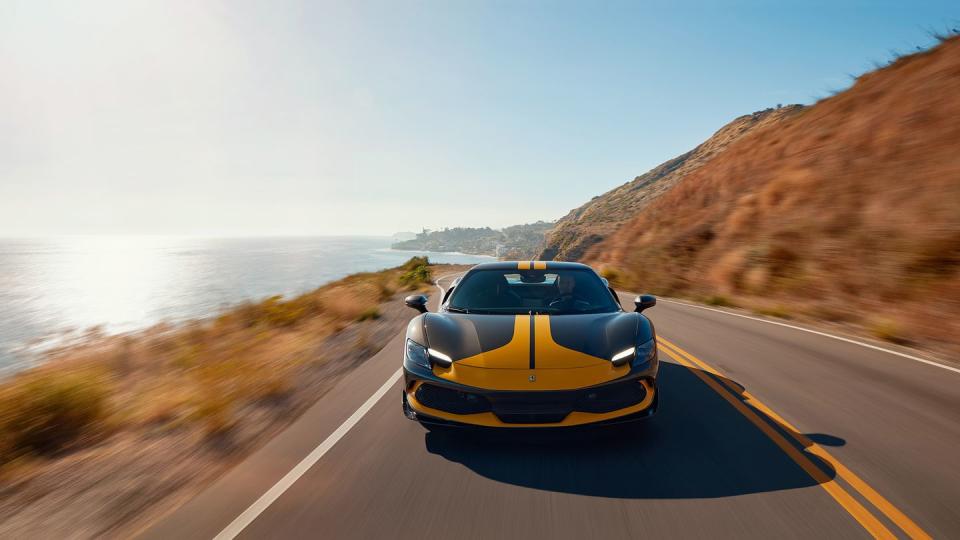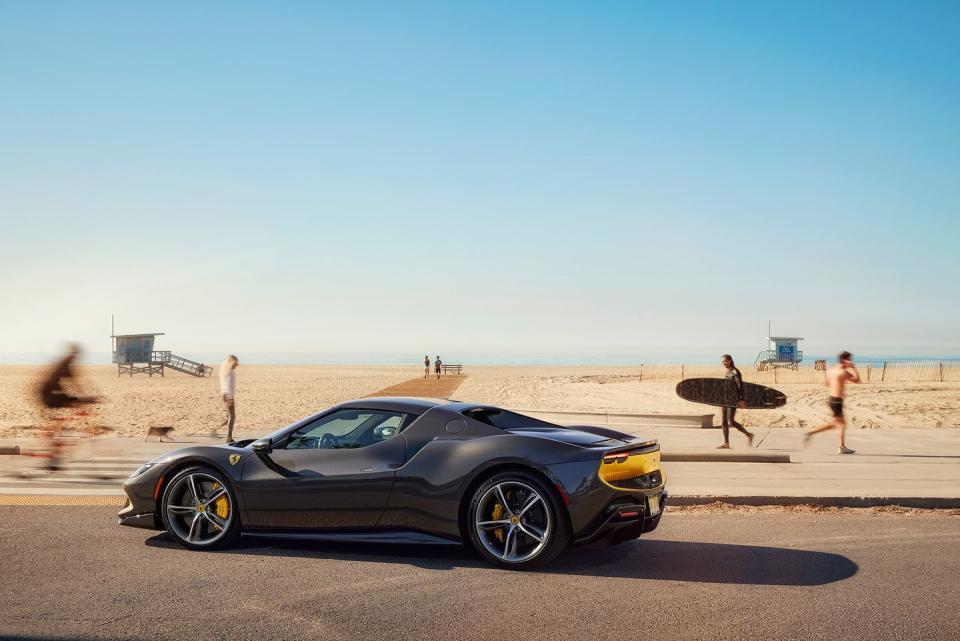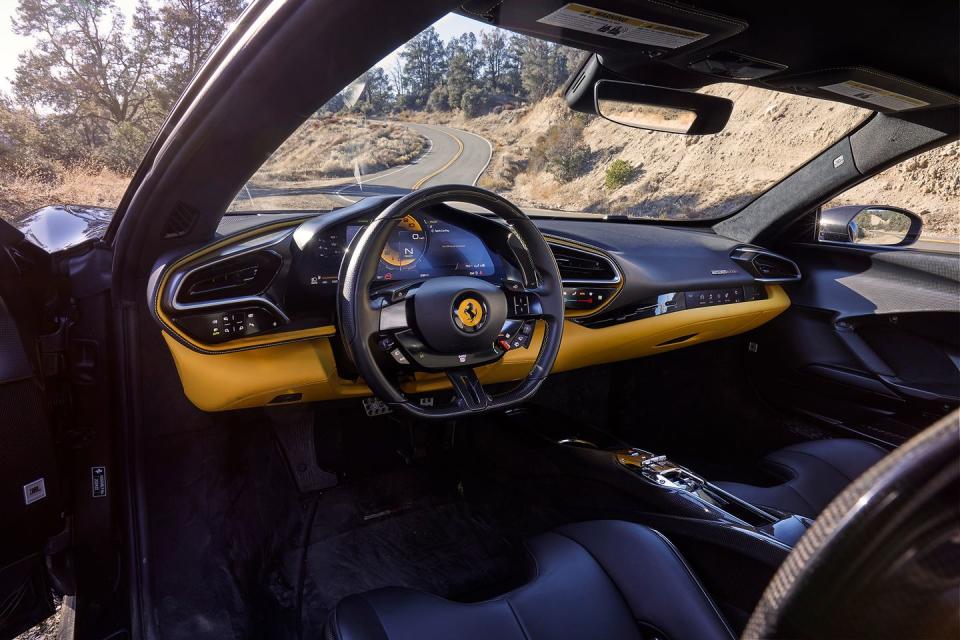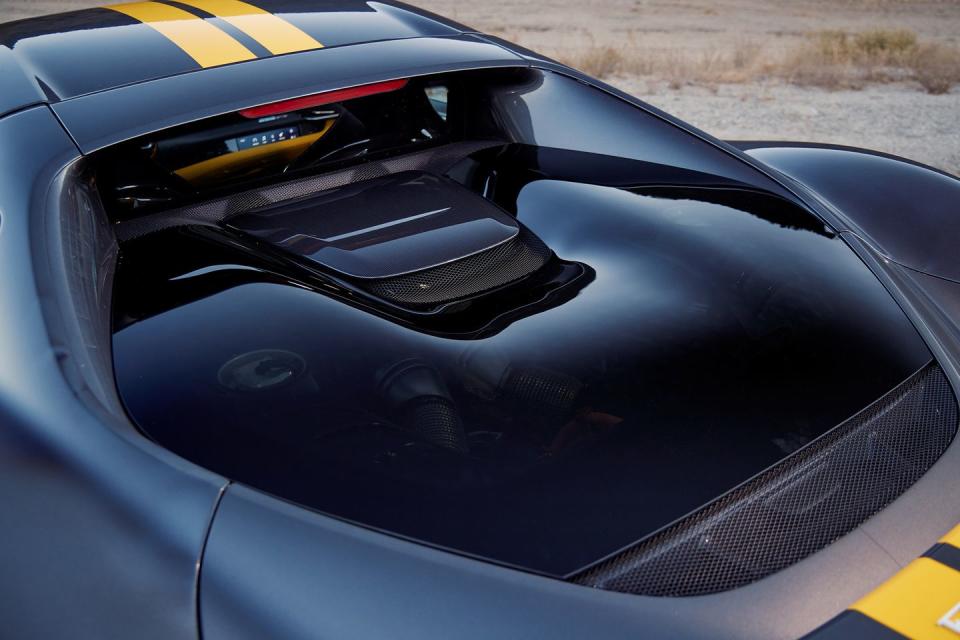Ferrari 296GTB Tested: You Won't Miss the V-8

From the March/April 2024 issue of Car and Driver.
Somewhere along the line, Ferrari decided it would be better for its cars to flatter their owners than to kill them. With few exceptions—the Enzo springs to mind—the modern Ferrari will tolerate a lot of buffoonery. Most mid-engine Ferraris from the past 20 years are so easy to drive, so benign at their limits, that you can get out and think you should immediately pursue an FIA license. But that chassis-tuning wizardry becomes harder to execute as horsepower climbs, natural aspiration gives way to turbochargers and electric motors, and the torque curve goes from a gentle rolling swell to an 80-foot breaker at Nazaré. By all rights, the Ferrari 296GTB should be nigh undrivable: 819 horsepower, 3532 pounds, rear-wheel drive. Its power-to-weight ratio slots between the Bugatti Veyron and the Bugatti Chiron Super Sport. The engineers tasked with controlling this thing must have been more stressed out than the night shift at Chernobyl.
And yes, it's a V-6. Ferrari calls the 296's twin-turbocharged 3.0-liter V-6 the "little V-12" because its 120-degree bank angle gives it the firing cadence of a V-12. We don't think anyone will confuse its aural signature with that of an 812 Superfast, but it definitely doesn't sound like any other V-6. It shrieks, yes, but there's also a guttural undertone that evokes the most recent Ford GT race cars, and the turbos chirp and whistle like a WRC car. If there was something almost organic about the big-cat keening of a 458 Italia, the 296GTB orchestrates a distinctly mechanical symphony. This is a machine with a singular purpose, like a trebuchet or the Terminator.

Lest you bemoan the 296's departure from Ferrari mid-engine Berlinetta tradition, from V-8s dating to Magnum P.I.'s 308GTB, know that the company's V-6 history goes back even further—Ferrari won the 1961 Formula One Constructors' Championship with a 120-degree V-6. But that one didn't make 654 horsepower all on its own, nor did it benefit from a 165-hp axial-flux motor pitching in. Speaking of F1: The 296GTB's V-6 hybrid powertrain mirrors the current race cars in a way the prior V-8s haven't for the past decade. And when you've got 819 horsepower behind your shoulders and an 8500-rpm redline, it's easy to indulge in an F1 fantasy or two. Our circuit: Los Angeles.
The plan is to head up to the high desert hills outside L.A. and, hopefully, find the kind of roads where a car like this can stretch out a little bit—inasmuch as that's possible with a machine that hits 60 mph in 2.4 seconds and covers the quarter-mile in 9.7 seconds at 150 mph. But we begin at Venice Beach, collecting the car from a hotel valet manager who doesn't even want to touch it. "I parked it, but if you want to get it out, you have to do it," he says. "I don't want anyone else driving this." We then do a track walk of sorts, all the way from the car's parking spot out to the street—where the garage ramp meets the road at a dauntingly steep angle. "What you do here," says the valet, "is take the widest angle you can and cheat the inside tires onto the curb so you can use that as a ramp." I can see why he didn't want to be responsible for possibly turning the 296's optional carbon-fiber rear diffuser ($11,812) into an expensive Italian road grader.

This particular 296GTB comes with the $41,956 Assetto Fiorano package (assetto is "trim" in Italian), a track-oriented options group that includes Multimatic spool-valve dampers with titanium springs. While the standard 296 has adaptive dampers and an available front-axle lift system, the ground clearance with the Multimatics is fixed. Assetto Fiorano also includes some aerodynamic enhancements and lightweight components—like a Lexan rear window—to drop a claimed 33 pounds. For further weight reduction, Ferrari will install $33,748 carbon-fiber wheels to shed a claimed 18 pounds. Most notably from the public's perspective, though, it unlocks the ability to order this car's peacocking two-tone paint job, which references the 1963 250LM. If you order Assetto Fiorano, you don't have to get the paint, but you can't have it unless you order Assetto Fiorano. Ferrari is unstinting in reminding its customers that no matter how much money they have, it makes the rules.
After sneaking the 296 over the curb and onto the street, we head toward the boardwalk to shoot some photos and canvass local sentiment—it's tough to take the public temperature on a new car while sealed inside a g-pod that attains 190 mph in 17.8 seconds. We quickly find that even car-jaded L.A. loves the 296GTB—and is maybe a little in awe of it. Almost immediately after we pull over, a guy leans in the window and says, "Your car is the definition of sex." Uh, thanks, sir. Another guy walks up and says, "This is beautiful. I've had Lamborghinis but always wanted a Ferrari." I ask him which Lamborghinis. "I don't know," he sighs, as if such things aren't worth keeping track of. I tell him that not knowing which Lamborghinis you owned is the most Lamborghini thing I've ever heard, and then we set off for a different part of the beach, waiting at an intersection as a Mercedes 300SL Gullwing casually bombs past.

This seems to be the right place to sample the 296GTB's eDrive mode, in which it cosplays as a reasonable electric vehicle, at least until its battery runs dry. The 296's trip computer tracks the percentage of time the car spends in each driving mode, and it's hilarious to see that this car has logged zero percent of its life in eDrive. I eke that up to 1 percent and consider that work done, but the 296's electric mode is useful as far as it goes, which isn't far—the range estimator maxes out at 14 miles. Most of the time, you could just leave the car in Hybrid mode (indeed, the trip computer shows that's the most frequently used mode, with a 75 percent score). More entertaining, though, are Performance and Qualify modes, which both fire the V-6 and charge the battery.
With the V-6 awake and all 819 horsepower and 546 pound-feet of torque at the ready, this car should be scary. To that point, you need only deactivate the traction-control system for a moment to appreciate its constant subtle work of saving your ass. You can burn up those 305/35ZR-20 rear tires—either the standard Michelin Pilot Sport 4S or Bridgestone Potenza Sport rubber or the optional Michelin Pilot Sport Cup 2 Rs, all developed specifically for this car—while rolling at 50 mph on the Pacific Coast Highway, but the ego-preservation systems keep all the drama to your lane. That's thanks in part to data gleaned from Ferrari's new six-way Chassis Dynamic Sensor, as well as its Side Slip Control system, which is constantly estimating grip at the pavement, even when you're not driving at the edge, so that it's ready to make fine-tuned adjustments when the limit arrives.

Once we escape the city, more than an hour north—to a roller coaster of a road that is both desert and deserted—the 296GTB proves that this level of performance can be, against all odds, approachable. Everything just happens a lot quicker than it did in any of the 296's predecessors. It's like a 488GTB on fast forward.
Good thing the 296 also has some of the best brakes of any road car. With the optional Cup 2 Rs, stopping from 70 mph requires only 130 feet. So, on a winding mountain road, you can inhale the straights in a frenzy of boost and then count on the six-piston front calipers and carbon-ceramic rotors to erase all that speed. Or most of it. The 296 happily digs in at 50 mph and claws its way around corners marked for 15 mph, flaunting its 1.12 g's of skidpad grip. Amazingly enough, that lateral-acceleration number could climb even higher on a fast sweeper thanks to the 296GTB's 794 pounds of downforce at 155 mph. The rear spoiler is active, while the front is fixed and features the "tea tray," which looks like a small T-shaped wing behind the bumper and creates a localized underbody vortex that produces increased suction and downforce over the front axle. With the rear spoiler down, the 296GTB looks curvaceous and slinky, like the pretty 1960s race cars that predated all the big-winged wind-tunnel creatures soon to follow. It's a neat trick to conjure that look while keeping a car glued to the pavement.

With Ferrari's LaFerrari and SF90 Stradale paving the way for the 296GTB, it's no surprise that it works so seamlessly right out of the box. There's no lack of linearity in the brake-by-wire system, whether the rear axle is recapturing energy or not, and the powertrain transitions from electric to hybrid as smoothly as a Prius—a Prius that's been gargling nitromethane, but still. The only mildly weird hybrid behavior is when the car is in eDrive mode at a constant speed. It sometimes can't quite decide whether to deploy power or recapture it and wavers on that seam.
Other off notes? The fact that the turn signals don't keep a steady cadence will surely bother those customers who specify a two-degree temperature range for the warm nuts served on their Gulfstreams. And the minimalist no-touchscreen interior aesthetic also means that basically every possible vehicular function is jammed onto the steering wheel. Then there's the price, which for this car is $538,399, a number that reflects over $220,000 in options. Ferrari will sell every one it deigns to build, of course, so it's not like the price matters to actual buyers. But a half-mil MSRP might harsh your "Maybe I'll own one of those someday" fantasies. Personally, I could live without this car's swell paint job and use that $35,788 to retain the team of lawyers I'd need to defend my driver's license.
I concede these are not devastating critiques, which doesn't surprise me because when anyone asks me what the best car is or what I would drive if I could drive anything, "Whatever the current mid-engine V-8 Ferrari is" has long been my go-to answer. For the first time since 1975, that's no longer true. And not because Ferrari finally fell off its game, but because it took the game in a whole new direction. Now you want the V-6 hybrid Ferrari. Yeah, that sounds strange to my ear too. You'll get used to it.
Counterpoints
An interested bystander scoffed when I told him the 296GTB had a V-6 engine and plug-in-hybrid hardware, but his tune would have been much different had he been riding shotgun when I dropped the hammer. The resulting 819-hp shove is breathtaking, and the wail and cadence of the 120-degree V-6 apes that of a V-12 as the eight-speed dual-clutch automatic cracks off shifts at the 8500-rpm redline. The amazing part is how effectively this regen system captures electricity under braking, so its exotic axial-flux electric motor is always primed and ready. It's almost as if Ferrari has years of experience with racing cars built to harvest and deploy electrical energy within the context of a single lap. —Dan Edmunds
Late night, mountain road, steady November rain, rear-wheel-drive 819-hp Ferrari. It sounds like the setup for a tragic tale—or Guns N' Roses lyrics. But the 296GTB doesn't sing sad songs. It plows through puddles with the surefootedness of a Land Rover and aims its lucha libre–esque mask at corner exits with the confidence of a compass pointing toward true north. If it's saving you from yourself, it's too polite to tell you. It feels like you're in control, no matter how slick the surroundings. All the driver and passenger know is that they arrive safely at dinner amid a surprisingly beefy V-6 rumble, get valet pride of place, and feel like a (half-)million bucks. Should you be lucky enough to get a go in the 296 on dry pavement, whew, that's Paradise City. —Elana Scherr
I muttered "whoa" enough while driving the 296 that I started feeling like Keanu Reeves, but the biggest mind melter isn't the car's performance. It's the tractability and approachability. In a day of winging the 296 around the Apennine Mountains outside Ferrari headquarters, I quickly worked my way up the manettino. Even in Race mode, there are a lot of power-reduction interventions, which is not surprising given the surfeit of thrust. So, I stepped it up to CT Off mode and quickly and comfortably started sliding the 296 in arcs nearly as picturesque as the surrounding countryside. Supercars with this much performance are typically edgy, peaky, and scary. Not this one. —Dave VanderWerp
You Might Also Like

 Yahoo Autos
Yahoo Autos 